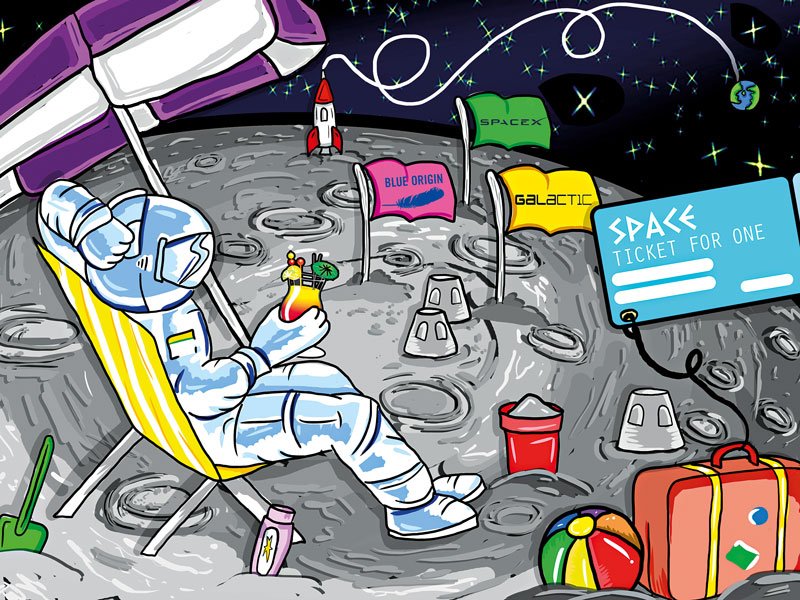SHATNER WEPT
The Space Race is on again. That is the race to space by commercial tech giants like Elon Musk and Jeff Bezos, plus real estate tycoon Robert Bigelow, Virgin Galactic’s Richard Branson and others. At some point before very long, space tourism will be a thing. And not just for the One Percenters who can afford the suborbital flights currently being offered where you can get your rocks off in a weightless spacey environment 60 miles up. That’s the demarcation point between “the Kármán line (the boundary between the Earth’s atmosphere and outer space),” according to World Finance, which pegs this fledging industry to be worth $3 billion in just seven years around 2030. I know, ultra-First World reality, but….
That is, assuming we don’t blow ourselves up with nukes over Ukraine/NATO/Putlerism/Taiwan or watch passively with our fossil fuel comforts as the planet overheats so much that a mass extinction event takes place. Or, you know, maybe an asteroid – one that can’t be nudged off course with one of our roman candle rockets -- comes barreling down anywhere on the globe and throws us all into a truly post-modern world that looks more like a bad pre-historic dinosaurs-roamed-the-earth flick.
Space Tourism…..( Credit World Finance)
Nope. Avoiding these cataclysms will allow planetary society to ford its way into space, which will present a unique challenge for anyone who can afford the ticket and happens to see a UFO/UAP while on their joy ride. Imagine how that playbook for damage control will look. But it seems inevitable. Astronauts and commercial pilots, even fighter pilots, are generally under strict rules not to discuss the bogeys they see in suborbital and deeper space. Granted, the proliferation of the Tic Tac videos and the testimony of Navy jocks who tracked them has changed public perception dramatically, if even only incrementally. Apparently these “unknowns” – if they are unknown -- are now permissible to view in mass media and on your phone.
Watch this space.
“'I suddenly started to weep': Shatner describes feeling of grief coming back from space.” –CNN
In the meantime, William Shatner’s recent interview with Anderson Cooper on CNN about his brief voyage into space moved him so much that he wept. I notice that guys of a certain age are much more vulnerable to their thoughts and emotions as they grow older, and old Captain Kirk is up there: Their tear ducts leak with even the slightest glimpse of baby elephant-rescue videos on Facebook and YouTube. And as the days slam forward, I’m increasingly in that demo. But the pretend-Star Trek pioneer cried for all the right reasons, based on all the wrong circumstances down here on the small blue marble.
Watch the interview here: https://www.cnn.com/videos/business/2022/10/18/william-shatner-space-flight-book-ac360-contd-vpx.cnn\
Contrast Shatner’s experience with that of Apollo astronaut Ed Mitchell, who I got to know a bit while working with CSETI, where he served as an advisor. Ed went to moon during the Apollo program, walked on it, and came home. But his flight back held a life-changing experience, as I write in my book, The Space Pen Club:
“Mitchell had experienced a cosmic epiphany while hurtling back from the moon in which he felt that everything was connected—the rare, elusive ‘Oneness’ —and sensed the universe itself was conscious. He writes eloquently about it in his book, The Way of the Explorer: An Apollo Astronaut’s Journey Through the Material and Mystical Worlds. Perhaps the best summary of the book is the July 2020 lead Amazon review:”
“Among authors trying to bridge the gap between science and spirit, former astronaut Mitchell brings unique credentials. Originally scheduled for the ill-fated Apollo 13 mission, Mitchell, as told in this smooth blend of autobiography and exegesis, journeyed to the Moon in 1971 (and generated great controversy over ESP experiments he conducted on the flight). As he gazed on Earth, surrounded by blackness and an unfathomable number of stars, he experienced ‘an overwhelming sense of universal connectedness’ that was to change his life. Within a few years, he had left NASA and founded the Institute of Noetic Sciences aimed at the systematic study of the nature of consciousness. At the institute, he came to some fascinating conclusions, detailed here and based on principles of resonance, regarding a possible natural explanation for psychic powers.”
Both men’s experiences are vastly different. And yet they’re not.
The night sky is a miracle that used to inspire awe. But today, too often we forget even to look up. The new James Webb telescope is hopefully reinventing awe and wonder. Or at least funneling outer space imagery back into our cerebral cortexes to process and ponder. Don’t let its images – or the occasional glance into the heavens overhead and all around us -- bypass your emotional center of gravity.


